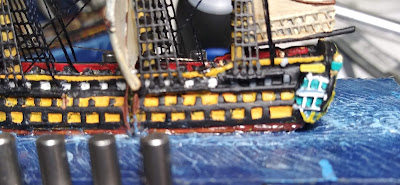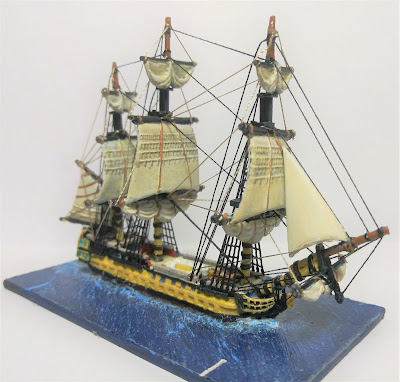The last two posts shared a title, since both of them were about the
Texas Broadside convention. In case you didn't recognize the line, it's from a Jimmy Buffett song entitled, "A Pirate Looks at Forty." Since my main game was about capturing prizes in the Age of Sail, I thought the lyrics of the chorus fit pretty well:
Yes I am a pirate
Two hundred years too late
The cannons don't thunder, there's nothing to plunder
I'm an over forty victim of fate
For the title of this post, I've gone a little farther back in time than 1974. Even with that, for those of us who are "of a certain age," this one should be an easy guess as well. Just as with the previous title, this one is modified but only very slightly.
Our subject this time is the Spanish 100-gun ship
Rayo, which according to Google Translate means "Thunderbolt" or "Lightning" in English. Yes, I skipped the obvious Bohemian Rhapsody jokes, and yes, you're welcome. The history of the real ship is pretty interesting, which is why there's a brief history lesson before we get to the usual pictures.
She was originally launched in 1749 as an 80-gun ship of the line named
San Pedro, and was commissioned into the Spanish Navy in 1751. She had the usual spells of activity and idleness during her career, and was laid up from 1798 to 1803. She was thought to be in poor shape by 1803, but her construction from tropical hardwoods (she was built in Havana) meant that she was still mostly sound. She was taken and converted into a 100-gun ship in 1803 by enclosing her upper deck, similar to how
Santisima Trinidad went from 112 to 136 guns in 1795-96. By January of 1805,
Rayo was in Cadiz. Later that year, she joined the Combined Fleet after it returned from the West Indies. She fought at Trafalgar, returned to Cadiz, and sortied again on October 23 to help recover the ships
Santa Ana and
Neptune. She was then driven ashore and shipwrecked in the storm following the battle. She was the oldest ship at the battle, being about 14 years older than
HMS Victory.
This particular model turned out to be a learning experience in more ways than one. Langton has begun casting its larger hulls in resin instead of metal, and this was my first experience working with one. Overall, the detail is every bit as good as the white metal hulls. Unfortunately, this model had damage to the starboard quarterdeck bulwark that would have made it impossible to run rigging lines. It looked like it had been broken instead of not having enough resin in the mold. Fortunately, I had some .010 plastic sheet, and a couple layers of that, combined with a bit of carving to shape,
made for a fairly quick repair.
 |
It's easy to see the difference between resin and metal detail in this photo.
Also, you can see the repairs to the quarterdeck bulwark. |
The sharp-eyed among you have already noticed other pieces of black plastic as well. Another problem with this hull is that some of the channels for the ratlines seem to be positioned incorrectly. Instead of ending in line with the hole for the mast, they end before the hole. Consequently, the brass ratlines should not align properly with the masts. The next picture will give a better idea of what I mean:
It is kind of a big deal. As the plan of
HMS Serapis below shows, the ratlines have to line up with the mast.
In fairness though, the Spanish 80 gun hull from Langton has the same problem, so I should have expected it. Unlike the metal hull, this resin one made a repair much easier. Take a piece of the .010 plastic sheet mentioned earlier, cut to roughly the right size, and glue them on. I had thought that I might have to support them from below, but once the glue dried they were remarkably sturdy. I won't say it's a perfect solution, but once paint is applied you can't tell the extensions are there. I should probably have trimmed the back of the channels to make them a bit smaller, but didn't want to run the risk of damaging them.
Other than that, painting and basing went mostly as expected. I decided to paint the ship based on some pictures I found on a website called Todo A Babor:
https://www.todoababor.es/ . If you're interested in the Spanish navy, then put this website in your bookmarks! There are articles, paintings and information on the Real Armada that I've not seen anywhere else. There is a definite shortage of English language information sources on the Spanish navy out there, and this is a useful corrective. The website itself is in Spanish, but Google Translate handles this quite well. Some of the more specific nautical terms may be mistranslated, but you can still figure out what they mean. Todo A Babor has a couple of different color paintings of
Rayo, but I decided to go with this one:
Another painting shows the ship with the third gun deck painted yellow (which would be in line with regulations), but I decided that I liked the look of this interpretation better. I decided to drill all the holes after the painting was done, and it was here that I discovered an odd problem. In a couple of places, the outer layer of paint flaked away from the primer when I drilled the hole. As you'll see from these photos, it looks like a bad problem:
 |
| No need for a circle here; the gray against black is very visible. |
All the above photos are at 3X zoom, so obviously these are very small spots that should touch up easily enough. I mention it only because I've never had it happen to a metal model before. Also, I prime my ships in black, so I'm not sure why it showed up gray after the paint flaked away.
With the running rigging in place as seen above, the running rigging was going quickly and I was feeling good about finishing this ship quickly. As I should know by now, that feeling is a prelude to something going wrong. It started when I cut a line on the running rigging and cut into the knot, so it came loose from the sail. In taking off the other end of that line, I accidentally cut the main mast standing rigging by mistake. Annoying, but not disastrous. While re-running the main mast standing rigging, I realized that the fragments from the old lines were making it impossible to get all the new ones through the hole. So I decided to enlarge the hole from .5 to .7 millimeters. After all, what could go wrong? This could:
 |
| AAAAAARRRRRRGGGGGHHHHH!!!!!! |
Yes, the bulwark broke into pieces. Fortunately, I was able to find the largest pieces and glue them back into place. What I couldn't find I was able to replace with some of that .010 plastic I mentioned before. I covered everything with super glue gel and waited for it to dry. What I got was this:
I re-threaded the mainmast rigging very gently, as I wasn't sure about the strength of my repairs. I wound up having to re-rig the mainmast a third time, as a rough spot on the hole cut the string during the first re-rigggng. A quick BUT CAREFUL re-drilling of the hole solved that problem and let me re-finish the standing rigging. After this three hour delay (I told you I was being careful), everything else went off without a hitch.
Well, that's enough grousing and extreme close-ups of ship damage. Below are the usual beauty shots of the finished vessel:
 |
Obviously the camera angle is a little off on this one.
I assure you, Rayo is not skidding through the sea at an angle! |
And since the Quarter of Comparison (TM) hasn't been seen in a while, here's a size comparison shot:
As a closing thought, this ship is also an example of the "check twice, paint once" adage. If you look at the drawing from the Todo a Babor website, you'll notice that the ship is NOT painted in the Nelson Checker pattern; instead, the gunports are open. I didn't notice this until after the ship was painted and partially rigged. I could have gone back and painted her properly, but it would have been fairly difficult. At that point, I decided it was just too late.






















































